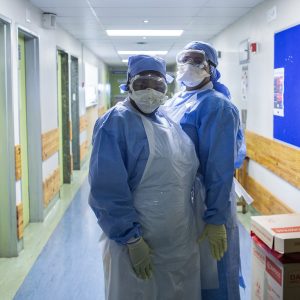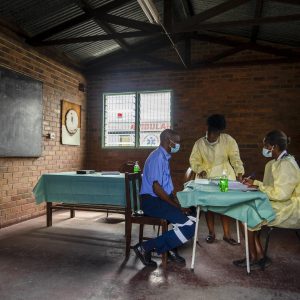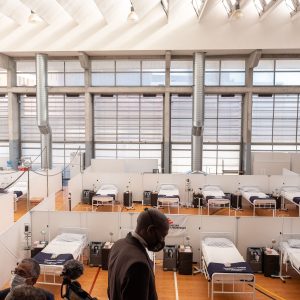Employing more nurses can reduce total health costs
Having sufficient numbers of nursing staff leads to better patient care and safety. This, in turn, lessens the financial burdens placed on the healthcare system, a study has found.
Author:
31 May 2021

A recent study published in The Lancet medical journal suggests that employing more nurses can result in cost savings double the cost of employing the additional nurses. The study was conducted in Australia but may well have important implications for nursing in South Africa.
The study, conducted across 55 hospitals in Queensland, suggests that a recent state policy to introduce a minimum ratio of one nurse to four patients for day shifts has successfully improved patient care, with a 7% drop in the chance of death and readmission and a 3% reduction in the length of stay for every one less patient a nurse has in their workload. It is these reductions in readmissions and the length of hospital stays that resulted in the cost savings.
Related article:
The study compared 27 hospitals where the policy was implemented with 28 hospitals where it was not implemented.
“Despite some evidence that more nurses in hospitals could benefit patient safety, similar policies have not been widely implemented across the globe, partly due to an absence of data on the long-term effects and costs, as well as limited resources,” read a press release from The Lancet.
“Our findings plug a crucial data gap that has delayed a widespread roll-out of nurse staffing mandates. Opponents of these policies often raise concerns that there is no clear evaluation of policy, so we hope that our data convince people of the need for minimum nurse-to-patient ratios by clearly demonstrating that quality nursing is vital to patient safety and care,” said Matthew McHugh, a professor at the University of the Pennsylvania School of Nursing in the United States and lead author of the study.
Similar in SA?
While we are not aware of similar research in South Africa, it seems plausible that meeting minimum nursing ratios here too could result in substantial cost-savings – through fewer readmissions and shorter hospital stays as observed in Australia, but potentially also by reducing the number of medico-legal claims against the government.
“Nurses offer a comprehensive service package in preventing diseases, promoting health, curing diseases and rehabilitative services. Healthcare costs will therefore be greatly reduced if more nurses were employed, especially with the revitalisation of primary healthcare and strengthening of community-based healthcare services,” says Khaya Xaba, spokesperson for the National Education, Health and Allied Workers’ Union. He adds that staff shortages in the nursing profession impact directly and negatively on the quality of nursing care and the delivery of quality healthcare services to healthcare users.
Related podcast:
Rich Sicina, a paediatric nurse and general secretary of the Young Nurses Indaba Trade Union, agrees that readmissions are an avoidable problem.
“Where I work, it’s like they take turns to use the bed, two weeks in and two weeks out. Patients are in and out because we can’t look after them thoroughly. Patients are discharged not because they are better, but [because] they have to open space for the next patient who is worse at that time. The system now forces nurses to choose who will be given more care and who will not. With this kind of care, we can only see more and more readmissions. All this can be avoided if there were more nurses,” he says, adding that most nurses, deep down, know that most of the deaths could have been avoided if there were more of them.
The big picture
That the world needs more nurses is not news. In its State of the World’s Nursing report, the World Health Organization (WHO) estimates there was a global shortage of 5.9 million nurses in 2018, a slight improvement from the 6.6 million shortage in 2016.
In South Africa, according to the 2030 “Human Resources for Health” strategy, there were 71 707 professional nurses, 31 039 enrolled nurses and 33 821 nursing assistants by 2019. The report further states that the density for all nurses combined is 282 per 100 000. A South African Nursing Council (SANC) report shows a slight decrease in the number of nurses in 2020.
According to the SANC, in 2020 there was one nurse (registered, enrolled or auxiliary nurse) for every 213 people in the country in both the public and private sector – a far cry from Australia’s one nurse for every four patients per shift. The pressures are especially high in the Northern Cape, with one nurse for every 350 people, and in Mpumalanga, which had one nurse for every 313 people.
Melanie Alperstein, steering committee member of the People’s Health Movement, says it has been well established that the number of nurses is way below the number needed. This, she says, impacts the work to be done as nurses are then overloaded with the amount of work they need to do.
Related article:
“Mistakes may be made. It is difficult to be caring and compassionate, and nursing care cannot be at the standard that nurses would like. Anxiety increases and affects the mental wellbeing of the nurses due to overload and not being able to practise in the way that needs to be done to meet patient safety and needs,” she says.
“Health budget cuts are one aspect outside of the profession and affect the number of all health workers needed for the country to be at an optimal level. Posts are frozen and qualified nurses are sitting at home without work. An example of this was the extra nurses employed in the Eastern Cape for a temporary period during Covid-19.
“There are more qualified nurses that could be employed, but budget cuts and possible bureaucracy have prevented this,” says Alperstein, adding that factors within nursing that need attention relate to policy, leadership, education, systemic fault lines in the health system such as stock-outs of supplies, crumbling and inadequate infrastructure, and therefore poor working conditions as well as low pay.
‘Silent moratorium’
Democratic Nursing Organisation of South Africa spokesperson Sibongiseni Delihlazo says the number of nurses in the country’s healthcare system is extremely low. He says the vacancy rate is very high, and what’s even worse is that even the funded positions no longer get filled as the government tries to reduce the so-called bloated public sector wage bill, including in the health sector.
“Contributing to non-filling of vacant posts is the silent moratorium in provinces [on] filling vacant positions. This is costing the healthcare system severely because it lowers its effectiveness in fighting community infections and illnesses. It also leads to work overload and staff burnout, depression and anxiety among healthcare workers who are overworked,” he says.
Delihlazo fears that this was the case even before the Covid-19 pandemic.
Related article:
“Fortunately for the country, there are still nurses that are available for employment who are sitting at home and not willing to go abroad like others. These are nurses who, mostly, have been funded by the government for their studies. But they are never employed, and the government would have wasted its own investment in human resources because over time they would have to let them go find work elsewhere,” he says.
Sicina says there is a gross shortage of staff. Where he works, he is the only professional nurse. He works with an enrolled nurse and two enrolled nurse assistants. “We look after about 45 kids in a ward at [any] given time. Ideally, we should be 12. Imagine the chaos in the hospital because there are gross shortages of staff. Nurses have to make sure that those that go to theatre are ready for theatre, those that need a scan are ready for a scan, and those that need drips are [having them] inserted.
“But we can’t do it all, because the number of patients outnumbers the nurses. There are mistakes made and some people die because a nurse noticed the dropping of all vital signs late and he or she was busy giving medication to other patients, or preparing another patient for a procedure. When you see there is something wrong with another patient, it is too late to do anything,” he says.
Change of curriculum
Xaba says the change in the nursing curriculum informed by the phasing out of legacy nursing programmes and introducing new nursing qualifications has resulted in almost six years in which no new nurses were produced.
“Producing fewer specialised nurses results in fewer skilled nursing professionals to respond adequately to the health needs,” he says. “Also, the accreditation of nursing education institutions has been rather slow progress and few nursing colleges have been able to provide new training programmes.”
Sicina echoes this and adds that with an intake of about 200 students across all the colleges in Gauteng, there is no way that the country will be able to produce enough nurses at this rate.
Related article:
“The change of the curriculum has messed up things. What is an intake of 200 students for all the colleges? Even if that is the intake number, it doesn’t mean all 200 will graduate. Nursing is tough and most of the students study while working and it becomes too much and they drop out. Even worse, with this new curriculum, universities are not taking in students because they can’t teach this new curriculum.
We need to increase the intake and produce more nurses,” he says, adding that with his intake in 2009, there were 356 students starting the course but fewer than 200 graduated. Many fell in love with the idea of being a nurse but the real work was tough, hence not everyone graduated.
The SANC had not responded to questions from Spotlight by the time of publishing. However, in a statement, Sizo Mchunu, SANC registrar and chief executive, said: “As the statutory body, the SANC is committed to assist in ensuring the production of competent nurse practitioners who will provide scientific, comprehensive and quality nursing to patients, families and communities within the legal and ethical framework. It is vital that the country trains enough nurse practitioners to replace those retiring so that the country continues to deliver quality care.”
During the SANC’s presentation at the National Health Insurance public hearings in Parliament recently, Mchunu, when pressed about nursing shortages, reminded the members that the SANC is not an employer but can support the government. The SANC, she says, is doing important legwork in raising awareness and providing information on nursing as a profession.
Do more to produce more
Delihlazo says the capacity of universities and colleges should be increased to ensure that we produce enough nurses as a country. “[The] WHO together with [the] International Council of Nurses last year on 7 April released a report on the State of World Nursing where it indicated that for every country to avoid crisis levels in terms of a severe shortage of nurses by the year 2030, each country must increase the intake of its nursing production each year by at least 8%. If not, then the world is likely to experience a global shortage of 10 million nurses by 2030. South Africa is not going according to this advice – in fact, it is going completely against it.”
Xaba says the inability to provide mentorship to nursing students impacts the quality of nursing cadres currently being produced.
Related article:
“[There is] inequitable skills distribution because the training of nurses has also been reduced as a result of staffing shortages. Nurses are overburdened due to increased workloads, contributing to negligence, high absenteeism and low staff morale. Therefore, this results in sub-optimal care rendered to patients and clients and high litigation rates, which impact on the scarce budget currently allocated to the health sector.”
Alperstein says nurses are not given respect and appreciation for the work they do. “Transforming nursing education has not been given the resources and urgency it needs in comparison with medical education transformation.
“Both medical and nursing education still focus on disease and illness, instead of how to deliver a comprehensive primary healthcare service through interdisciplinary health teams and intersectoral collaboration within communities [and] with community structures to deal with the social determinants of health that cause the increased burden of disease in the first place,” she says, adding that all these issues need to be tackled to improve the nursing profession.
*This article was first published in Spotlight.






